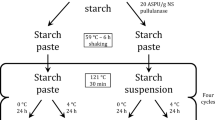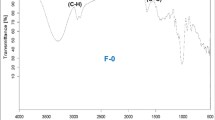Summary
Aspergillus fumigatus strain 4, cultured on citrus pectin as the sole carbon source, produced polygalacturonases whose activity was optimum at 65°C and pH 3.5–4.5. The enzymes presented a bimodal thermostability for 10 min, but not 60 min, of incubation. Polygalacturonases showed pH stability between 3.0 to 9.0. The enzymes were stable when stored at 4–6°C for 90 days, but their activity was reduced by 24% when they were stored at 26–30°C. Orange pulp was the best pectic carbon source tested for the production of pectinases capable of retting ramie fibers. The reutilization of these enzymes was possible, suggesting the viability of industrial use of pectinases for degumming ramie fibers.
Similar content being viewed by others
References
Araujo, E.F., E.G. Barros, R.A. Caldas and D.O. Silva. 1983. Beta-glucosidade activity of a thermophilic cellulolytic fungus,Humicola sp. Biotechnol. Lett. 5: 781–784.
Baracat, M.C., C. Valentim, J.J. Muchovej and D.O. Silva. 1989. Selection of a pectinol tic fungi for degumming of natural fibres. Biotechnol. Lett. 11: 899–902.
Baracat, M.C., M.C.D. Vanetti, E.F. Araujo and D.O. Silva. 1991. Growth conditions of a pectinolyticAspergillus fumigatus for degumming of natural fibres. Biotechnol. Lett. 13: 693–696.
Bellamy, D.F. 1979. Role of thermophiles in cellulose recycling. ASM News 45: 326–331.
Deshpande, K.S. and Gurucharanam. 1985. Degumming of ramie fibres: role of cell wall degrading enzymes ofAspergillus versicolor. Indian J. Bot. 8: 79–81.
Ghildyal, N.P., S.V. Ramakrishna, P.N. Devi, B.K. Lonsane and H.N. Asthana. 1981. Large scale production of pectolytic enzyme by solid state fermentation. J. Food Sci. Technol. 18: 248–251.
Harris, J.E. and C. Dennis. 1980. Heat stability of endopolygalacturonase of mucoraceous spoilage fungi in relation to canned fruits. J. Sci. Food Agric. 31: 1164–1172.
Harris, J.E. and C. Dennis. 1982. Heat stability of fungal pectolytic enzymes. J. Sci. Food Agric. 33: 781–791.
Rexová-Benková, L. and O. Markovic. 1976. Pectic enzymes. In: Advances in carbohydrate—chemistry and biochemistry. (Tipson, R.S. and D. Horton, eds.), Vol. 33, pp. 323–385, Academic Press, New York.
Sharma, H.S.S. 1988. Microorganisms in processing of flax. In: Biotechnology. (Rehm, H.-J. and G. Reed, eds.), Vol. 6B, pp. 746–755, VCH Verlagsgesellschaft, Weinheim.
Tani, T. and H. Nanba. 1969. Qualitative nature of macerating activities in the culture filtrates ofBotrytis cinerea. Ann. Phytopathol. Soc. Japan 35: 1–9.
Zetelaki-Horváth, K. 1978. Factors influencing kinetic constants of endo-PG fermentation. Acta Alim. 7: 209–23.
Author information
Authors and Affiliations
Rights and permissions
About this article
Cite this article
Baracat-Pereira, M.C., Dantas Vanetti, M.C., de Araujo, E.F. et al. Partial characterization ofAspergillus fumigatus polygalacturonases for the degumming of natural fibers. Journal of Industrial Microbiology 11, 139–142 (1993). https://doi.org/10.1007/BF01583713
Received:
Revised:
Accepted:
Issue Date:
DOI: https://doi.org/10.1007/BF01583713




